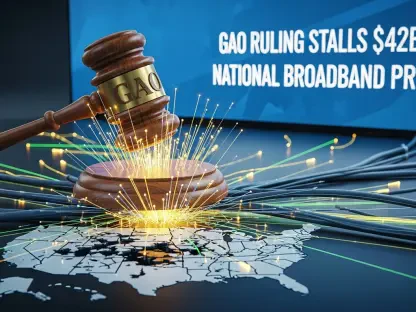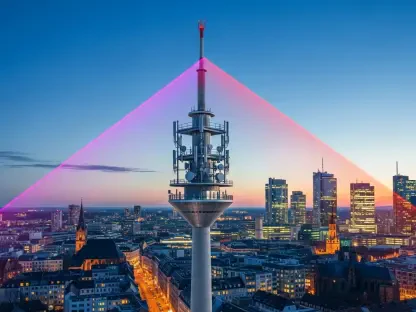In a seismic shift for the U.S. telecommunications industry, a staggering $23 billion all-cash deal between AT&T and EchoStar has sent shockwaves through the market, propelling EchoStar’s stock to soar by more than 75% in a single trading session. This monumental transaction, which transfers approximately 50 megahertz of mid-band and low-band spectrum across over 400 markets, positions both companies at a critical juncture in the race for 5G dominance. With regulatory approval pending and an anticipated closure by mid-2026, the agreement highlights the fierce competition for spectrum—a cornerstone of modern connectivity—as mobile data demand continues to skyrocket. Beyond the eye-popping financials, this deal reflects deeper strategic maneuvers, competitive pressures, and the evolving landscape of wireless services in America.
The dramatic rise in EchoStar’s stock price signals robust investor confidence in the transformative potential of this agreement, not just as a financial windfall but as a strategic realignment for the company. Meanwhile, AT&T’s stock nudged up by less than 1%, suggesting a more cautious outlook among investors wary of the substantial cost and existing debt obligations. This transaction transcends mere numbers; it embodies the urgent need for infrastructure to support the digital economy. As data consumption surges, driven by streaming, gaming, and remote work, the stakes for securing reliable spectrum have never been higher, setting the stage for a redefinition of connectivity across the nation.
Strategic Moves in the Telecom Landscape
AT&T’s Push for 5G Dominance
AT&T’s acquisition of this vast spectrum block marks a pivotal moment in its ongoing battle to keep pace with industry giants like Verizon and T-Mobile, who have maintained a lead in 5G deployment and spectrum holdings. The mid-band and low-band frequencies, prized for their extensive coverage and ability to penetrate buildings, are essential for expanding 5G services, particularly in rural and suburban areas where connectivity gaps persist. With mobile data usage having spiked dramatically in recent years due to high-bandwidth activities, this deal equips AT&T to address consumer demand more effectively. Industry analysts view this as a bold step to enhance network capacity and integrate 5G with fiber-optic broadband, creating a seamless connectivity ecosystem that could redefine user experiences across diverse regions.
Furthermore, the strategic importance of this move cannot be overstated, as it positions AT&T for long-term growth in an era where 5G is just the beginning. The company aims to leverage these assets to develop higher-margin services and prepare for future technologies like 6G, which are expected to emerge within the next few years. While short-term financial strain from the $23 billion price tag raises eyebrows among some investors, the potential to narrow the competitive gap with rivals offers a compelling upside. If regulatory hurdles are cleared by mid-2026, AT&T could roll out enhanced services that not only boost subscriber numbers but also strengthen its foothold in the rapidly evolving telecommunications market, ensuring relevance in an increasingly data-driven world.
EchoStar’s Calculated Exit
EchoStar’s decision to divest this significant spectrum portfolio to AT&T represents a deliberate shift away from direct competition in the wireless network space, opting instead for a substantial financial boost and strategic repositioning. Under mounting pressure from the Federal Communications Commission (FCC) over allegations of underutilizing its spectrum licenses—often termed “warehousing” by critics such as SpaceX—this sale offers a timely escape from potential regulatory penalties. The $23 billion cash influx strengthens EchoStar’s balance sheet, providing the resources to weather industry challenges while avoiding the capital-intensive demands of building out a competitive 5G network on its own. This move signals a pragmatic acknowledgment of the company’s limitations in keeping pace with telecom titans.
Additionally, the transaction allows EchoStar to refocus on its core competencies in satellite and TV services, while still maintaining a presence in the wireless sector through strategic partnerships. By sustaining its Boost Mobile brand via a hybrid mobile network operator model with AT&T, EchoStar ensures continued relevance in the prepaid wireless market, catering to cost-conscious consumers. This arrangement leverages AT&T’s enhanced network infrastructure, potentially improving service reliability for Boost customers who have often faced inconsistent coverage. The deal, therefore, not only mitigates regulatory risks but also carves out a sustainable path forward, allowing EchoStar to play to its strengths in niche markets rather than overextending in a fiercely competitive arena.
Market and Consumer Impacts
Investor Reactions and Financial Stakes
The market’s response to this landmark deal has been strikingly divergent, with EchoStar’s stock experiencing an extraordinary surge of over 75%, reaching heights not seen in recent memory. This dramatic uptick reflects investor enthusiasm for the substantial cash infusion and the strategic clarity the transaction brings to EchoStar’s future. The deal is perceived as a masterstroke, transforming underutilized assets into a financial lifeline that could fund innovation or debt reduction. Such a reaction underscores the market’s belief in the value unlocked by this sale, positioning EchoStar favorably among shareholders who see this as a defining moment for the company’s trajectory in the telecommunications sector.
In contrast, AT&T’s stock edged up by less than 1%, revealing a more reserved sentiment among investors cautious about the hefty $23 billion cost, particularly given the company’s existing debt burden. While the acquisition promises to bolster AT&T’s competitive stance, the immediate financial implications weigh heavily on market perceptions. Analysts suggest that although short-term pressures are evident, the long-term potential for growth in connectivity services and readiness for future technologies could justify the investment. This cautious optimism hints at a wait-and-see approach, with investors likely to monitor how AT&T translates this spectrum into tangible gains in network performance and customer acquisition over the coming years.
Consumer Benefits and Risks
For consumers, the implications of this spectrum transfer are multifaceted, offering the promise of enhanced connectivity, particularly in underserved rural and suburban regions where reliable service remains a challenge. The mid-band and low-band spectrum acquired by AT&T is ideally suited for wide-area coverage and strong indoor penetration, addressing longstanding gaps in mobile data access. As AT&T expands its 5G network with these assets, users in less densely populated areas could experience significant improvements in streaming, remote work capabilities, and other data-intensive applications. This development holds the potential to bridge digital divides, ensuring more equitable access to modern telecommunications services across the country.
However, alongside these benefits lurks the risk of reduced competition due to market consolidation, a concern that could impact consumer choice and pricing in the long run. As AT&T strengthens its position among the top U.S. wireless carriers, the concentration of spectrum assets among a few major players might limit the competitive dynamics that often drive innovation and affordability. Regulatory bodies are expected to scrutinize this aspect closely during the approval process, weighing the advantages of improved coverage against the possibility of higher costs or fewer options for consumers. The balance between network enhancement and market diversity will be a critical factor in determining the ultimate impact on the public, shaping how this deal is perceived beyond corporate boardrooms.
Broader Industry and Regulatory Dynamics
Competitive Shifts in the Wireless Market
The U.S. wireless market, long dominated by a trio of major players—Verizon, AT&T, and T-Mobile—stands at a crossroads with this spectrum deal reshaping competitive dynamics. T-Mobile has led in customer growth and spectrum assets since its merger with Sprint, while Verizon has carved a niche with premium pricing and ultra-wideband 5G services. AT&T, often seen as playing catch-up, gains a significant edge with this acquisition, potentially narrowing the gap with its rivals. The infusion of 50 megahertz of prime spectrum across numerous markets equips AT&T to enhance its 5G offerings, challenging competitors on both coverage and service quality. This shift could spark a ripple effect, prompting rivals to accelerate their own network investments or explore strategic acquisitions to maintain market share.
Moreover, the intensified competition might translate into tangible benefits for subscribers as carriers vie for dominance. With AT&T poised to expand its reach, particularly in underserved areas, the pressure on T-Mobile and Verizon to match or exceed service improvements could lead to more aggressive pricing strategies or innovative bundled offerings. However, the flip side is a potential stabilization of market shares among the big three, reducing the incentive for smaller players to disrupt the status quo. As this deal unfolds, its influence on industry competition will likely become a focal point, with analysts watching closely to see if it fosters a more dynamic market or entrenches existing hierarchies, ultimately shaping the wireless experience for millions of users.
Regulatory and Geopolitical Challenges
The regulatory landscape surrounding this spectrum deal adds a layer of complexity, with the FCC tasked with ensuring that such a critical public resource is utilized efficiently for the broader good. EchoStar’s sale comes amid scrutiny over its alleged failure to fully deploy its spectrum licenses, a contention fueled by competitors like SpaceX, which has pushed for reallocation to satellite-based services. The FCC’s oversight will be crucial in determining whether this transaction aligns with public interest goals, particularly in preventing spectrum hoarding while promoting widespread connectivity. The approval process, expected to conclude by mid-2026, will likely involve rigorous examination of how AT&T plans to deploy these frequencies to maximize consumer access and network reliability.
On a broader scale, the deal ties into geopolitical imperatives, as U.S. carriers face pressure to maintain technological leadership in the global 5G race against international competitors like Huawei. Spectrum consolidation by AT&T is seen as a step toward bolstering domestic capabilities, aligning with national security priorities to ensure American dominance in next-generation technologies. This urgency is compounded by the need to prepare for future innovations like 6G, where early investments in infrastructure could yield significant advantages. As regulatory bodies balance corporate interests with national goals, the outcome of this transaction will resonate beyond industry borders, influencing how the U.S. positions itself in the global telecommunications arena amid evolving technological and political challenges.
Future of Connectivity Convergence
The intersection of terrestrial and satellite connectivity emerges as a defining theme in the wake of this spectrum deal, highlighting a future where traditional wireless services might increasingly integrate with satellite solutions. With players like SpaceX’s Starlink advocating for spectrum access to serve rural areas through broadband services, the industry faces new competitive and regulatory frontiers. AT&T’s acquisition, while focused on terrestrial expansion, occurs against a backdrop of growing interest in hybrid models that could combine the strengths of both technologies. This convergence promises to address connectivity disparities in remote regions, but it also raises questions about spectrum allocation and the balance of power between established carriers and emerging satellite providers.
Looking ahead, the long-term outlook for the telecom sector suggests a landscape of both opportunity and contention as these technologies evolve. If approved, AT&T could solidify its market position by 2027, potentially offering bundled solutions that integrate 5G, fiber, and even satellite connectivity for comprehensive coverage. EchoStar, having secured its financial future through this sale, can focus on niche satellite and TV services, avoiding direct competition with telecom giants. Meanwhile, the industry must navigate complex challenges, from establishing spectrum-sharing standards to harmonizing regulatory frameworks that accommodate diverse connectivity models. This deal, in retrospect, marked a turning point, setting the stage for innovation and debate as the digital economy continues to expand in scope and significance.









